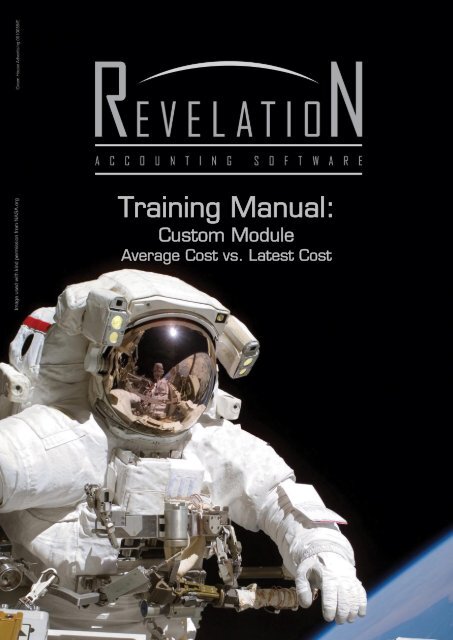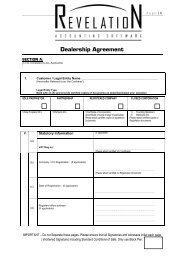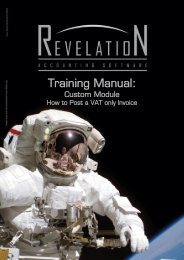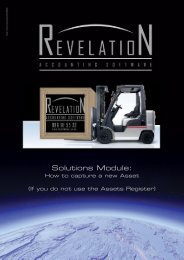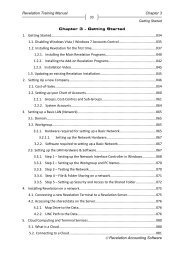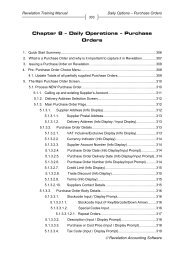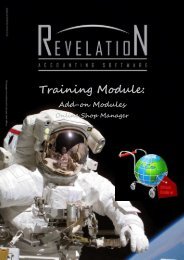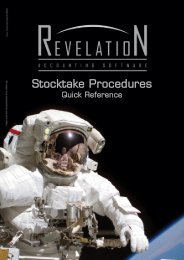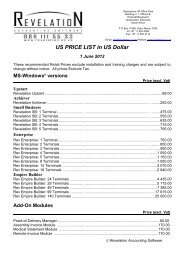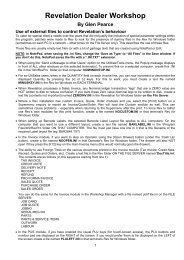Training Manual: - Revelation
Training Manual: - Revelation
Training Manual: - Revelation
You also want an ePaper? Increase the reach of your titles
YUMPU automatically turns print PDFs into web optimized ePapers that Google loves.
<strong>Revelation</strong> <strong>Training</strong> <strong>Manual</strong><br />
0<br />
Average Cost<br />
Latest Cost<br />
<strong>Training</strong> <strong>Manual</strong>:<br />
Custom Module<br />
Average Cost vs. Latest Cost<br />
<strong>Revelation</strong> Accounting Software
<strong>Revelation</strong> <strong>Training</strong> <strong>Manual</strong><br />
1<br />
Average Cost<br />
Latest Cost<br />
LICENCE<br />
The <strong>Revelation</strong> Package (herein after referred to as "the Package") is protected by both<br />
South African Copyright law and International Treaty Provisions. <strong>Revelation</strong> Accounting<br />
Software authorises you to make backup copies of the Package for the sole purpose of<br />
protecting your investment.<br />
The Package may be used by any number of people and may be freely moved from one<br />
computer location to another, provided there is no possibility of it being used by two different<br />
people in two different places at the same time (unless on the same Local Area Network) as<br />
this will constitute a violation of the Copyright Licence.<br />
WARRANTY<br />
With respect to the physical diskette and physical documentation enclosed herein,<br />
<strong>Revelation</strong> Accounting Software warrants the same to be free of defects in materials and<br />
workmanship for a period of 30 days from the date of purchase. In the event of notification<br />
within the warranty period of defects in material or workmanship, <strong>Revelation</strong> Accounting<br />
Software will replace the defective diskette or documentation. The remedy for breach of this<br />
warranty shall be limited to replacement and shall not encompass any other damages,<br />
including but not limited to loss of profit, and special, incidental, consequential, or other<br />
claims.<br />
DISCLAIMER<br />
<strong>Revelation</strong> Accounting Software specifically disclaims all other warranties, expressed or<br />
implied, including, but not limited to, implied warranties of merchantability and fitness for a<br />
particular purpose with respect to defects in the diskette and documentation, and the<br />
program license granted herein in particular, and without limiting operation of the program<br />
license with respect to any particular application, use, or purpose. In no event shall<br />
<strong>Revelation</strong> Accounting Software be liable for any loss of profit or any other commercial<br />
damage, including, but not limited to, special, incidental, consequential or other damages<br />
which may be incurred while using the Package. The Package is only sold on this<br />
understanding. Your purchase of this package implies your acceptance of this clause.<br />
All rights are reserved by <strong>Revelation</strong> Accounting Software. No part of this publication may<br />
be reproduced, transmitted, transcribed, stored in a retrieval system or translated into any<br />
language, in any form or by any means, electronic, mechanical, magnetic, chemical, manual<br />
or otherwise without prior written permission from <strong>Revelation</strong> Accounting Software.<br />
<strong>Revelation</strong> Accounting Software reserves the right to revise this publication and to make<br />
changes to the Package from time to time without obligation of <strong>Revelation</strong> Accounting<br />
Software to notify any person of such revision or changes.<br />
TRADEMARKS<br />
IBM is a trademark of International Business Machines.<br />
MsDos, Windows, Excel and Visual Basic are trademarks of Microsoft.<br />
Novell and Netware are trademarks of Novell, Inc.<br />
Copyright (c) 1988-2011 by <strong>Revelation</strong> Accounting Software. All Rights Reserved.<br />
<strong>Revelation</strong> Accounting Software
<strong>Revelation</strong> <strong>Training</strong> <strong>Manual</strong><br />
2<br />
Average Cost<br />
Latest Cost<br />
Note: We have taken every care to assure that this manual is as up to date as possible. Due to<br />
the nature of development, however, components may have been removed or added as situations<br />
dictate. Please contact the <strong>Revelation</strong> R&D Department in the event that the manual does not meet<br />
your requirements.<br />
<strong>Revelation</strong> Accounting Software
<strong>Revelation</strong> <strong>Training</strong> <strong>Manual</strong><br />
3<br />
Average Cost<br />
Latest Cost<br />
Average Cost vs. Latest Cost<br />
1. What is Cost Price and when do I use Average and Latest Cost………………001<br />
2. How is Cost price calculated in <strong>Revelation</strong>? Average, Latest............................003<br />
3. Which price to use in Calculating new Selling Prices? Average or Latest.........004<br />
4. Use which Cost Price in comparisons................................................................005<br />
Attention<br />
Tip<br />
Hot Tip<br />
Warning!<br />
Smarties<br />
Bright Sparks<br />
<strong>Revelation</strong> Accounting Software
<strong>Revelation</strong> <strong>Training</strong> <strong>Manual</strong><br />
4<br />
Average Cost<br />
Latest Cost<br />
1. What is Cost Price and when do I use Average and When Latest?<br />
The term “Cost Price” refers to the actual price that was paid for an item that is kept<br />
in stock. If you purchased a Widget at R 10.00, the cost price of the item is R 10.00.<br />
This is simple. If I had to ask what the monitory value of the stock is that you<br />
currently hold, you will tell me it is worth R 10.00 (at Cost) We are not interested in<br />
the selling price value of the item at this time, as it is only a potential value that only<br />
becomes a reality when the item actually gets sold. In accounting selling potential is<br />
never considered when determining value.<br />
Now, when you buy stock on different times and at different cost prices, things seem<br />
to get a bit more complicated. You have two problems to solve. The first problem is<br />
to calculate the value of the stock that you hold. The second problem is to calculate<br />
a new selling price for the stock that you hold. To solve these problems, the<br />
industry came up with two calculation concepts, Average and Latest Cost.<br />
Latest Cost is usually only used as a tool to work out what the new selling price<br />
should be for an item that was just bought. The understanding is that the more you<br />
pay for an item, the more the client should be paying for the item. The assumption is<br />
that you will usually pay more rather than less for items every time new stock is<br />
purchased.<br />
A further assumption is that if the Latest cost of the item is in actual fact less than<br />
the previous times, the Latest cost should still be used to calculate the new selling<br />
price; otherwise your business will no longer be competitive. The difference in the<br />
cost prices of items bought at different cost’s, should be to your benefit, not the<br />
clients. If you bought a Widget last year at R 5.00 and now buy another Widget at<br />
R20.00, you would like to charge the Client the same price for both widgets (Let’s<br />
say R 40.00). On the older widget, you will make R35.00 Profit, on the new widget, R<br />
20.00. The higher profit on the one widget should in theory cover your cost for<br />
carrying the item in stock for an extended period.<br />
Average Cost is used to solve the second problem; how to tell what the value in<br />
terms of equity you are holding on the books. Another name for the term Average<br />
Cost is “On-hand Stock Value”, (at the actual price you paid for stock). The word<br />
“Average” is a bit misleading as it points to the calculation method used to work out<br />
the value of multiple units, rather than what it represents.<br />
The definition of the word Average is to calculate or Balance out.<br />
“The result obtained by adding several quantities together and then<br />
dividing this total by the number of quantities; the mean.”<br />
To work out what the average value (what you paid for it) of two items of the same<br />
stock code is, you simply average them out. How do you do this, well, by adding both<br />
items cost prices (what you paid for each) together, and then by dividing them with<br />
the quantity on-hand. If you want to work out the average age of a group of people,<br />
you would use exactly the same calculation. You are 35 years old. You wife is 33.<br />
<strong>Revelation</strong> Accounting Software
<strong>Revelation</strong> <strong>Training</strong> <strong>Manual</strong><br />
5<br />
Average Cost<br />
Latest Cost<br />
Add the two ages together and then divide them by two. (35 + 33 = 68. 68 / 2 = 34).<br />
Your combined average age is then 34.<br />
The same principle is applies when you have two<br />
buckets of Water, the one 5 Litres and the other 7<br />
Litres. The minute you add a pipe to connect them<br />
(GRN), one Litre of water will run from the 7 Litre<br />
bucket to the 5 Litre Bucket in order to average out<br />
the 5 Litre bucket (due to gravity). The result is that<br />
both the buckets will contain 6 Litres. Now this is<br />
the secret to working with average cost pricing.<br />
BOTH buckets BECOME 6 Litres. They both loose<br />
their original volumes by the averaging process.<br />
Stock works in exactly the same way. When two stock items are placed together on<br />
an accounting platform, they both loose their original cost price by applying the same<br />
average costing engine. This holds true even when you place more than two items<br />
are bought at different prices. The principle remains.<br />
The new cost price of all the stock now becomes equal via the Average calculation.<br />
Assuming the holes are sealed instantaneously, once the pipes are disconnected,<br />
the buckets remain at the same (equal) level.<br />
<strong>Revelation</strong> Accounting Software
<strong>Revelation</strong> <strong>Training</strong> <strong>Manual</strong><br />
6<br />
Average Cost<br />
Latest Cost<br />
2. How is Cost price calculated in <strong>Revelation</strong>? Average, Latest<br />
There is a lot of confusion over how average cost price is calculated in Accounting<br />
packages. Some users are under the INCORRECT impression that this is calculated<br />
over a period of time. In other words, how much did an item cost from March 2011 to<br />
February 2012. Nothing could be further from the truth. Average cost is calculated<br />
based purely on the amount of stock items CURRENTLY in stock. Each time new<br />
stock is purchased, a new average price is calculated, based on the existing stock<br />
and the new stock that is being added. No calculation is done when stock is sold.<br />
To calculate average cost, the system takes the existing stock quantity and then<br />
adds it to the new quantity. This results in a new On-hand quantity. It then takes the<br />
existing stock value and adds it to the new stock value. The resulting total is then<br />
simply divided by the quantity on-hand. This is why, when stock is sold to Zero, when<br />
new stock is then bought, the average and latest cost then become the same. This is<br />
also the reason you should avoid selling stock into minus, as you are no longer able<br />
to calculate the cost price. All the system can do is remembering the old cost price<br />
before the stock became zero. If the new stock does not arrive at the same price as<br />
what the negative stock was sold at, profit losses and gains result.<br />
Let’s look at an example: You have 1 Widget in stock that was purchased at R 10.00.<br />
At this stage the Average and Latest Cost is exactly the same, R 10.00.<br />
Now you purchase (GRN) another Widget from a different supplier at R 20.00. Your<br />
new on-hand quantity is 2. You then add the two cost prices (R 10.00 + R 20.00 =<br />
R 30.00). Now divide the result (R30.00) by the quantity on-hand. (R 30.00 / 2 =<br />
R 15.00) Your new Average Cost for both items is then R 15.00. The R15.00 then<br />
becomes the items NEW COST PRICE PER ITEM.<br />
<strong>Revelation</strong> Accounting Software
<strong>Revelation</strong> <strong>Training</strong> <strong>Manual</strong><br />
7<br />
Average Cost<br />
Latest Cost<br />
3. Which price to use in Calculating new Selling Prices? Average or Latest<br />
Again, this should be a “No Brainer”; however people still struggle with this concept.<br />
In the current economic climate, it is safe to assume that prices go up all the time.<br />
The logical thinking should then be that the more you pay for goods, the more clients<br />
should pay for them. But what about your old stock? Well, the fact that you have<br />
stock that was purchased at a lower cost price than the stock that just arrived<br />
yesterday should be to your advantage. Surely you will have to replace the stock<br />
once it is sold. Both old and new stock will have to be replaced by new stock at the<br />
(we assume) latest cost price. Therefore logic dictates that the client should pay the<br />
same price for the old and new stock.<br />
For this reason we should always use the Latest Cost Price to calculate Selling<br />
Prices. The extra profit on the older stock should be seen as your reward for keeping<br />
stock (as the money could have been in the bank earning interest instead of laying in<br />
stock).<br />
To change the stock from average markup to Latest markup, simply click on the Edit<br />
button. Under the Cost/Markup section, change the On Latest/Average from “A” to<br />
“L”.<br />
If you would like to change all of the stock codes in one go, go to the Master File<br />
Updates button. Now select [Stock Master File]. And then >> [Amend a Field in ALL<br />
records].<br />
You may now look for and select the option to amend the “Markup on<br />
Latest/Average” and move it to the Right (Active) column.<br />
<strong>Revelation</strong> Accounting Software
<strong>Revelation</strong> <strong>Training</strong> <strong>Manual</strong><br />
8<br />
Average Cost<br />
Latest Cost<br />
Now Type in “L” for Latest and then press the Save button and....Presto, it is done.<br />
You may now also set the system so that all new stock items will, by default, be set<br />
to “Latest”. To setup this option select the System Preferences button. Under stock,<br />
change the “Set ‘Markup on’ to this Cost in new stock” to [Latest].<br />
4. Use which Cost Price in comparisons<br />
Again, I am amazed on how the users get confused on this issue. When you want to<br />
compare your stock value to the value in the Trial Balance, it is important that you<br />
use the correct cost price on both. We have already stated that when new stock is<br />
purchased; it is added to your existing stock. The cost prices are then added<br />
together and divided into the on-hand quantity. This in effect means that the stock on<br />
the Trial Balance should also reflect this value. In order for this to happen, you really<br />
don’t have a choice, the Cost Price<br />
being used for comparisons (Actual<br />
valuation via the Stock Report vs. the<br />
Value on the TB) MUST be set to<br />
Average. If not, every time you buy<br />
stock, the existing stock will<br />
automatically be re-valued to the latest<br />
cost. Your Trial Balance and Stock<br />
Valuation will then always be out by the<br />
difference in Average to Latest Cost. If<br />
you do attempt to change this setting,<br />
the system gives you a nice big red<br />
warning – DON”T DO IT.<br />
<strong>Revelation</strong> Accounting Software


